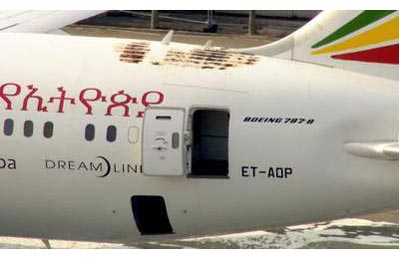
Dreamliner probe looks at several components
London/Washington, July 17, 2013
British investigators said on Tuesday said they were looking at a number of components, including a transmitter made by US firm Honeywell, as they searched for the source of a fire on a Boeing 787 Dreamliner in London last week.
Britain's Air Accidents Investigation Branch (AAIB) is leading the investigation into a blaze that broke out on a parked Ethiopian Airlines jet last Friday.
The fire caused extensive damage to the upper portion of the jet's rear fuselage, which has raised questions about whether the composite plane can be repaired, analysts say.
The UK agency has sought to allay fears about a return of problems with overheating batteries that grounded the Dreamliner for months earlier this year but investors are anxious for more details about the cause of Friday's fire.
"People are taking stock of the relative uncertainty surrounding the 787," said aviation consultant Richard Aboulafia with the Virginia-based Teal Group. "There's a lot of complex electrical systems on this plane, and there's also the realisation that we don't know what the repair of this airplane will look like or what the implications are."
Industry experts said repairing the damaged airplane could take months or a year. If Boeing opts to replace the entire tail section, that also could mean a long delay because there is no slack in the production line, they said.
The focus on the emergency beacon has raised alarms for some analysts, who said more technology problems with the new, high-tech airliner would be troubling.
"It's good to see the AAIB are getting closer to finding out what happened but what we really need to know now is if this is a one off or a problem for the whole Dreamliner fleet - that is the crucial point for Boeing and airlines," said Howard Wheeldon, an aerospace analyst at Wheeldon Strategic Advisory.
"We can confirm that Honeywell have been invited to join the investigation," a spokesman for the AAIB said on Tuesday.
"The emergency locator transmitter (ELT) is one (of) several components being looked at in detail as part of the investigation and it would be premature to speculate on the causes of the incident at this stage."
The ELT, which is positioned in the upper rear part of the new airline, sends a signal that leads rescuers to downed aircraft. It is powered by a non-rechargeable lithium-manganese battery.
The AAIB spokesman declined to identify any other components that might be under scrutiny as possible causes of the fire.
Boeing shares closed down 1.4 per cent to $104.23 on Tuesday, still comfortably above the $75 range seen during the three-month grounding of 787s related to overheating problems with its power backup batteries.
A source familiar with the probe told Reuters on Monday that investigators were looking specifically at the location transmitter's lithium manganese battery made by Ultralife Corp , a Newark, New York-based company.
Ultralife's shares closed 3 cents lower at $3.97 on the Nasdaq stock exchange on Tuesday. Ultralife declined to comment.
US aviation officials cautioned against jumping to any conclusions that the emergency beacon or its battery caused the fire, saying many components were damaged in the blaze, which made it difficult to determine where the fire broke out.
Honeywell says it has built and sold over 3,000 of the emergency beacons since they were first certified in 2005 and there have been no safety incidents. Company officials say they have not seen or experienced a single reported issue with the emergency beacons, in use on a wide range of airplanes.
Honeywell shares closed down 27 cents, or 0.3 per cent lower, at $82.03 on the New York Stock Exchange on Tuesday. - Reuters







